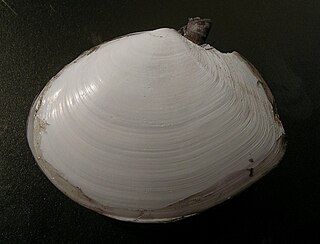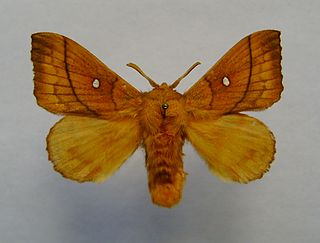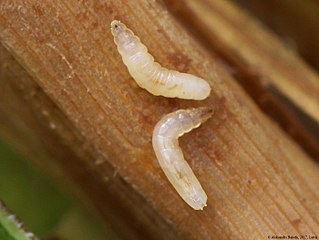
Lipari is a comune including six of seven islands of the Aeolian Islands and it is located in the Tyrrhenian Sea off the northern coast of Sicily, southern Italy; it is administratively part of the Metropolitan City of Messina. Its population is 12,821, but during the May to September tourist season, the total population may reach up to 20,000. It is also the name of the biggest island in the archipelago, where the main urban area of the comune is located.

Lepidoptera is an order of insects that includes butterflies and moths. About 180,000 species of the Lepidoptera are described, in 126 families and 46 superfamilies, 10 percent of the total described species of living organisms. It is one of the most widespread and widely recognizable insect orders in the world. The Lepidoptera show many variations of the basic body structure that have evolved to gain advantages in lifestyle and distribution. Recent estimates suggest the order may have more species than earlier thought, and is among the four most speciose orders, along with the Hymenoptera, Diptera, and Coleoptera.

The Battle of the Lipari Islands or Battle of Lipara was a naval encounter fought in 260 BC during the First Punic War. A squadron of 20 Carthaginian ships commanded by Boödes surprised 17 Roman ships under the senior consul for the year Gnaeus Cornelius Scipio in Lipara Harbour. The inexperienced Romans made a poor showing, with all 17 of their ships captured, along with their commander.

Eupterotidae is a family of insects in the order Lepidoptera with more than 300 described species.

Myconita is a genus of moths in the family Gelechiidae.

Baliochila is a genus of butterflies, commonly called buffs, in the family Lycaenidae. They are found only in the Afrotropical realm.

Macoma is a large genus of saltwater clams, marine bivalve molluscs in the family Tellinidae, the tellins.

Euproctis is a genus of tussock moths in the family Erebidae described by Jacob Hübner in 1819. Species are cosmopolitan, widespread throughout Palearctic, African, Oriental and Australian regions. Molecular phylogenetic studies indicate that the genus as presently understood comprises a large number of unrelated lineages, only a few of which have names, and is therefore in serious need of revision.

Odonestis is a genus of moths in the family Lasiocampidae described by Ernst Friedrich Germar in 1812. It consists of twenty-two species, which is found in Europe, Russia, Asia Minor, China and Japan.
Lipara is a genus of flies in the family Chloropidae. Among the Palearctic species, a specific community of bees and wasps make their nests in the galls of chloropid flies. Most frequently, they use the galls induced by Lipara lucens on common reed stems. Some of these aculeate hymenopteran species, such as the digger wasp Pemphredon fabricii (Crabronidae) or the solitary bee Hylaeus pectoralis (Colletidae) are specialized for nesting in galls induced by Lipara spp. more than a year ago.
Baliochila lipara, the Lipara buff, is a butterfly of the family Lycaenidae. It is found in Malawi and from Zimbabwe to the coast of eastern Kenya. It has recently been discovered in the Manguzi and Temble areas of KwaZulu-Natal, South Africa. The habitat consists of deciduous woodland and savanna at altitudes ranging from 500 to 1,000 metres.

Procometis is a genus of moths in the family Autostichidae.

Myconita plutelliformis is a moth in the family Gelechiidae. It was described by Snellen in 1901. It is found in India, Indonesia (Java) and Australia, where it has been recorded from the Northern Territory and Queensland.
Procometis lipara is a moth in the family Autostichidae. It was described by Edward Meyrick in 1890. It is found in Australia, where it has been recorded from New South Wales.
Thioscelis is a moth genus of the family Depressariidae.
Thioscelis lipara is a moth in the family Depressariidae. It was described by W. Donald Duckworth in 1967. It is found in Amazonas, Brazil.
Eugene Gordon Munroe was a Canadian entomologist who discovered numerous species of insects. He worked for the Insect Systematics and Biological Control Unit, Entomology Division in Ottawa, Ontario, Canada.
Acrassus or Akrassos was an ancient Roman and Byzantine-era city in Lydia. in the Roman province of Asia and Lydia. Apparently, it is the same place that Ptolemy calls Nacrasa or Nakrasa, placed on the road from Thyatira to Pergamum.

Lipara lucens is a species of frit fly in the family Chloropidae. It is found in Europe.
Gaius Aurelius Cotta was a Roman general and statesman. He was consul in 252 BC, with Publius Servilius Geminus, and both consuls carried on the war in Sicily against the Carthaginians with great success. Among several other places they also took Himera, but its inhabitants had been secretly removed by the Carthaginians. Afterwards Cotta borrowed ships from Hiero, and having united them with the remnants of the Roman fleet, he sailed to Lipara, the blockade of which he left to his tribune, Quintus Cassius, with the express order not to engage in a battle; but, during the absence of the consul, Cassius notwithstanding allowed himself to be drawn into an engagement, in which many Romans were killed. On being informed of this Cotta returned to Lipara, besieged and took the town, put its inhabitants to the sword, and deprived Cassius of his office of tribune. Cotta was celebrated for the strict discipline which he maintained among his troops, and of which several instances are on record. During the siege of Lipara one of his own kinsmen, Publius Aurelius Pecuniola, was scourged and degraded to the rank of a common soldier, because through his fault a part of the camp was set on fire, in consequence of which almost the whole camp fell into the hands of the enemy. It was probably during the same campaign, that he acted with great rigour towards the equites who refused to obey his commands. At the close of his consulship Cotta triumphed over the Carthaginians and Sicilians. In 248 he obtained the consulship a second time, together with his former colleague, Servilius Geminus, and again fought in Sicily against the Carthaginians. Carthalo in vain endeavoured to make a diversion by attacking the coasts of Italy.










